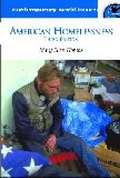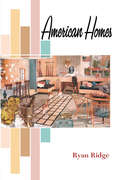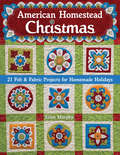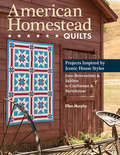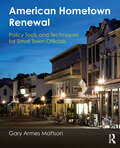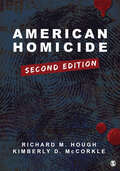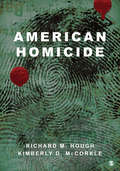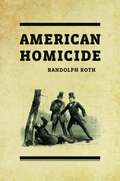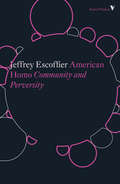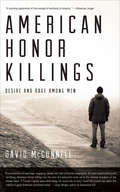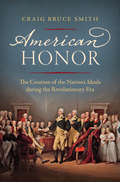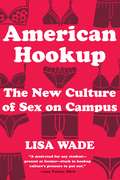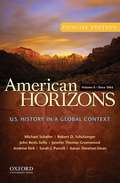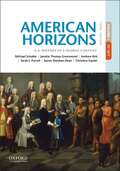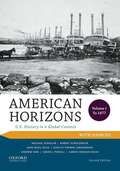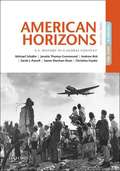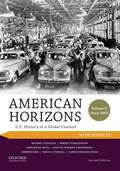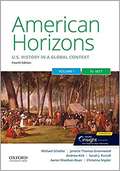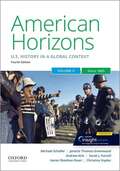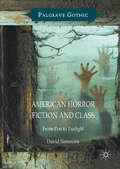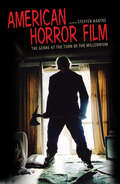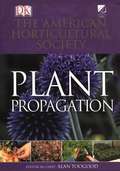- Table View
- List View
American Home Products Corp.
by David W. Mullins Jr.American Home Products is a company with virtually no debt. Students are asked to analyze the company's debt policy and make a recommendation to the CEO. It is likely that adding debt to the capital structure would create some value for shareholders; the CEO is firmly against borrowing.
American Homelessness: A Reference Handbook (3rd edition)
by Mary Ellen HombsHombs (of the Massachusetts Housing and Shelter Alliance) offers a collection of reference materials that provide information on the pervasive problem of homelessness in the United States. Nine chapters offer a chronology of the homeless problem, brief biographical sketches of 20 people who have had an effect on homeless policy and research, statistical information, documents and government reports, legislation from the U.S. and Europe written to address the problem, a list of print and nonprint resources, and a directory of organizations and government agencies. Also included is a brief analysis and discussion of the problem, comparing Europe and the United States.
American Homes
by Ryan RidgePoetry / Fiction / Art / Aphorisms. American Homes incorporates poetry, prose, and various schematic devices, including dozens of illustrations by the artist Jacob Heustis, to create a cracked narrative of the domestic spaces we inhabit.
American Homestead Christmas: 21 Felt & Fabric Projects for Homemade Holidays
by Ellen MurphySimple to stitch, perfect for gifts: Make your Christmas crafty with handmade ornaments, stockings, tree skirts, and more!American Homestead is back again—this time with charming small projects you can sew anytime, anywhere. Ellen Murphy shares twenty-one embroidered felt and quilted designs for the holidays in her signature folk-art style. These classic patterns can also be stitched up in alternate colors to be suitable all year round. Festive projects, from all-new felt ornaments to cheerful stockings, make beautiful tree trimmings and treasured gifts for family and friends.
American Homestead Quilts: Projects Inspired by Iconic House Styles from Brownstone & Saltbox to Craftsman & Farmhouse
by Ellen MurphyPair timeless quilt designs and classic American homes with this book featuring “lyrical commentary [and] clear how-tos” (Publishers Weekly).Designer Ellen Murphy has created unique quilts inspired by the colors and shapes of American houses. From colonial farmhouses to brownstones, these quilts will beautify any décor. This book includes patterns and complete instructions for nine traditional pieced quilts in a variety of sizes and color palettes, plus inspirational photos featuring iconic American homes. Classic-styled quilts are perfect for building your sewing skills: Begin with simple squares and work your way up to more challenging diamond patterns.
American Hometown Renewal: Policy Tools and Techniques for Small Town Officials
by Gary A. MattsonBefore the interstates, Main Street America was the small town’s commercial spine and served as the linchpin for community social solidarity. Yet, during the past three decades, a series of economic downturns has left many of the great small cities barely viable. American Hometown Renewal is the first book to combine administrative, budgetary, and economic analysis to examine the economic and fiscal plight currently facing America’s small towns. Featuring a blend of theory, applications, and case studies, it provides a comprehensive, single-source textbook covering the key issues facing small town officials in today’s uncertain economy. Written by a former public manager, university professor, and consultant to numerous small towns in the Heartland, this book demonstrates the ways in which contemporary small towns throughout the nation are facing economic challenges brought about by the financial shocks that began in 2008. Each chapter explores a theme related to small town revival and provides a related tool or technique to enable small town officials to meet the challenges of the 21st Century.?Encouraging local small town officials to look at the economic orbit of communities in a similar manner as a town’s budget or a family’s personal wealth, examining its specific competitive advantages in terms of relative assets to those of competing communities, this book provides the reader with step-by-step instructions on how to conduct an asset inventory and apply key asset tools to devise a strategy for overcoming the challenges and constraints imposed upon spatially-fixed communities. American Hometown Renewal is an essential primer for students studying city management, economic community development, and city planning, and will be a trusted handbook for city managers, geographers, city planners, urban or rural sociologists, political scientists, and regional microeconomists.
American Homicide
by Richard M. Hough Kimberly D. McCorkleAmerican Homicide examines all types of homicide, and gives additional attention to the more prevalent types of murder and suspicious deaths in the United States. Authors Richard M. Hough and Kimberly D. McCorkle employ more than 30 years of academic and practitioner experience to help explain why and how people kill and how society reacts. This brief, yet comprehensive book takes a balanced approach, combining scholarly research and theory with compelling details about recent cases and coverage of current trends. Comparative coverage of homicide types and rates in countries around the world shows how American homicide statistics compare internationally.
American Homicide
by Richard M. Hough Kimberly D. McCorkleAmerican Homicide examines all types of homicide, and gives additional attention to the more prevalent types of murder and suspicious deaths in the United States. Authors Richard M. Hough and Kimberly D. McCorkle employ more than 30 years of academic and practitioner experience to help explain why and how people kill and how society reacts. This brief, yet comprehensive book takes a balanced approach, combining scholarly research and theory with compelling details about recent cases and coverage of current trends. Comparative coverage of homicide types and rates in countries around the world shows how American homicide statistics compare internationally.
American Homicide
by Richard M. Hough Professor Kimberly D. McCorkleAmerican Homicide examines all types of homicide, and gives additional attention to the more prevalent types of murder and suspicious deaths in the United States. Authors Richard M. Hough and Kimberly D. McCorkle employ more than 30 years of academic and practitioner experience to help explain why and how people kill and how society reacts. This compressive text takes a balanced approach combining scholarly research and theory with compelling details about recent cases and coverage of current trends.
American Homicide
by Richard M. Hough Professor Kimberly D. McCorkleAmerican Homicide examines all types of homicide, and gives additional attention to the more prevalent types of murder and suspicious deaths in the United States. Authors Richard M. Hough and Kimberly D. McCorkle employ more than 30 years of academic and practitioner experience to help explain why and how people kill and how society reacts. This compressive text takes a balanced approach combining scholarly research and theory with compelling details about recent cases and coverage of current trends.
American Homicide
by Randolph RothIn American Homicide, Randolph Roth charts changes in the character and incidence of homicide in the U.S. from colonial times to the present. Roth argues that the United States is distinctive in its level of violence among unrelated adults—friends, acquaintances, and strangers. America was extraordinarily homicidal in the mid-seventeenth century, but it became relatively non-homicidal by the mid-eighteenth century, even in the slave South; and by the early nineteenth century, rates in the North and the mountain South were extremely low. But the homicide rate rose substantially among unrelated adults in the slave South after the American Revolution; and it skyrocketed across the United States from the late 1840s through the mid-1870s, while rates in most other Western nations held steady or fell. That surge—and all subsequent increases in the homicide rate—correlated closely with four distinct phenomena: political instability; a loss of government legitimacy; a loss of fellow-feeling among members of society caused by racial, religious, or political antagonism; and a loss of faith in the social hierarchy. Those four factors, Roth argues, best explain why homicide rates have gone up and down in the United States and in other Western nations over the past four centuries, and why the United States is today the most homicidal affluent nation.
American Homo: Community and Perversity
by Jeffrey EscoffierA sweeping account of the way lesbian, gay, and bisexual people have challenged and changed societyIn this provocative book, Jeffrey Escoffier tracks LGBT movements across the contested terrain of American political life, where they have endured the historical tension between the homoeroticism coursing through American culture and the virulent periodic outbreaks of homophobic populism. Escoffier explores how every new success enables a new disciplinary and normalizing form of domination; only the active exercise of democratic rights and participation in radical coalitions allows LGBT people to sustain the benefits of community and the freedom of sexual perversity.
American Honor Killings: Desire and Rage Among Men
by David McconnellIN AMERICAN HONOR KILLINGS, straight and gay guys cross paths, and the result is murder. But what really happened? What role did hatred play? What about bullying and abuse? What were the men involved really like, and what was going on between them when the murder occurred? This book explores the truth behind squeamish reporting and uninformed political rants of the far right or fringe left. David McConnell, a New York-based novelist, researched cases from small-town Alabama to San Quentin's death row. The book recounts some of the most notorious crimes of our era.<P> BEGINNING IN 1999 and lasting until last year's conviction of a youth in Queens, New York, the book shows how some murderers think they're cleaning up society. Surprisingly, other killings feel almost preordained, not a matter of the victim's personality or actions so much as a twisted display of a young man's will to compete or dominate. We want to think these stories involve simple sexual conflict, either the killer's internal struggle over his own identity or a fatally miscalculated proposition. They're almost never that simple.<P> TOGETHER, THE CASES FORM A SECRET AMERICAN HISTORY of rage and desire. McConnell cuts through cant and political special pleading to turn these cases into enduring literature. In each story, victims, murderers, friends, and relatives come breathtakingly alive. The result is more soulful, more sensitive, more artful than the sort of "true crime" writing the book was modeled on. A wealth of new detail has been woven into old cases, while new cases are plumbed for the first time. The resulting stories play out exactly as they happened, an inexorable sequence of events--grisly, touching, disturbing, sometimes even with moments of levity.
American Honor: The Creation of the Nation's Ideals during the Revolutionary Era
by Craig Bruce SmithThe American Revolution was not only a revolution for liberty and freedom, it was also a revolution of ethics, reshaping what colonial Americans understood as "honor" and "virtue." As Craig Bruce Smith demonstrates, these concepts were crucial aspects of Revolutionary Americans' ideological break from Europe and shared by all ranks of society. Focusing his study primarily on prominent Americans who came of age before and during the Revolution—notably John Adams, Benjamin Franklin, Thomas Jefferson, and George Washington—Smith shows how a colonial ethical transformation caused and became inseparable from the American Revolution, creating an ethical ideology that still remains.By also interweaving individuals and groups that have historically been excluded from the discussion of honor—such as female thinkers, women patriots, slaves, and free African Americans—Smith makes a broad and significant argument about how the Revolutionary era witnessed a fundamental shift in ethical ideas. This thoughtful work sheds new light on a forgotten cause of the Revolution and on the ideological foundation of the United States.
American Hookup: The New Culture of Sex on Campus
by Lisa WadeA revelatory account of the new culture of sex that has come to dominate the American college experience. The hookup is now part of college life. Yet the drunken encounter we always hear about tells only a fraction of the story. Rising above misinformation and moralizing, Lisa Wade offers the definitive account of this new sexual culture and demonstrates that the truth is both more heartening and more harrowing than we thought. Offering invaluable insights for parents, educators, and students, Wade situates hookup culture within the history of sexuality, the evolution of higher education, and the unfinished feminist revolution. Using new research, she maps out a punishing emotional landscape marked by unequal pleasures, competition for status, and sexual violence. She discovers that the most privileged students tend to like hookup culture the most, and she considers its effects on racial and sexual minorities, students who “opt out,” and those who participate ambivalently. Accessible and open-minded, compassionate and brutally honest, American Hookup explains where we are and how we got here, asking not “How do we go back?” but “Where do we go from here?”
American Horizons, Concise: U. S. History in a Global Context, Volume II: Since 1865
by Michael Schaller Janette Thomas Greenwood Aaron Sheehan-Dean Robert Schulzinger Andrew Kirk Sarah J. Purcell John BezIs-Selfa<p>American Horizons is the only U.S. History survey text that presents the traditional narrative in a global context. The seven-author team uses the frequent movement of people, goods, and ideas into, out of, and within America's borders as a framework. This unique approach provides a fully integrated global perspective that seamlessly contextualizes American events within the wider world. The authors, all acclaimed scholars in their specialties, use their individual strengths to provide students with a balanced and inclusive account of U.S. history. <p>Presented in two volumes for maximum flexibility, American Horizons illustrates the relevance of U.S. history to American students by centering on the matrix of issues that dominate their lives. These touchstone themes include population movements and growth, the evolving definition of citizenship, cultural change and continuity, people's relationship to and impact upon the environment, political and ideological contests and their consequences, and Americans' five centuries of engagement with regional, national, and global institutions, forces, and events. In addition, this beautifully designed, full-color book features hundreds of photos and images and more than one hundred maps.</p>
American Horizons: U. S. History In A Global Context, Volume I
by Michael Schaller Janette Thomas Greenwood Christina Snyder Aaron Sheehan-Dean Andrew Kirk Sarah J. PurcellAmerican Horizons, Third Edition, presents the traditional narrative of U.S. history in a global context. The authors use the frequent movement of people, goods, and ideas into, out of, and within America's borders as a framework. This unique approach provides a fully integrated global perspective that seamlessly contextualizes American events within the wider world. The authors, all acclaimed scholars in their specialties, use their individual strengths to provide students with a balanced and inclusive account of U.S. history. Presented in two volumes for maximum flexibility, American Horizons, Third Edition, illustrates the relevance of U.S. history to American students by centering on the matrix of issues that dominate their lives. These touchstone themes include population movements and growth, the evolving definition of citizenship, cultural change and continuity, people's relationship to and impact upon the environment, political and ideological contests and their consequences, and Americans' five centuries of engagement with regional, national, and global institutions, forces, and events. In addition, this beautifully designed, full-color book features hundreds of photos and images and more than 100 maps.
American Horizons: U. S. History in a Global Context (Volume 1 #1877)
by Michael Schaller Janette Thomas Greenwood Aaron Sheehan-Dean Robert Schulzinger Andrew Kirk Sarah J. Purcell John Bezis-SelfaAmerican Horizons, Second Edition, is the only U. S. History survey text that presents the traditional narrative in a global context. The authors use the frequent movement of people, goods, and ideas into, out of, and within America's borders as a framework. This unique approach provides afully integrated global perspective that seamlessly contextualizes American events within the wider world. The authors, all acclaimed scholars in their specialties, use their individual strengths to provide students with a balanced and inclusive account of U. S. history. Presented in two volumes for maximum flexibility, American Horizons, Second Edition, illustrates the relevance of U. S. history to American students by centering on the matrix of issues that dominate their lives. These touchstone themes include population movements and growth, the evolving definitionof citizenship, cultural change and continuity, people's relationship to and impact upon the environment, political and ideological contests and their consequences, and Americans' five centuries of engagement with regional, national, and global institutions, forces, and events. In addition, thisbeautifully designed, full-color book features hundreds of photos and images and more than 100 maps.
American Horizons: U.S. History In A Global Context, Volume II: Since 1865
by Michael Schaller Janette Thomas Greenwood Christina Snyder Aaron Sheehan-Dean Robert Schulzinger Andrew Kirk Sarah J. Purcell John Bezis-SelfaAmerican Horizons, Third Edition, presents the traditional narrative of U.S. history in a global context. The authors use the frequent movement of people, goods, and ideas into, out of, and within America's borders as a framework. This unique approach provides a fully integrated global perspective that seamlessly contextualizes American events within the wider world. The authors, all acclaimed scholars in their specialties, use their individual strengths to provide students with a balanced and inclusive account of U.S. history. Presented in two volumes for maximum flexibility, American Horizons, Third Edition, illustrates the relevance of U.S. history to American students by centering on the matrix of issues that dominate their lives. These touchstone themes include population movements and growth, the evolving definition of citizenship, cultural change and continuity, people's relationship to and impact upon the environment, political and ideological contests and their consequences, and Americans' five centuries of engagement with regional, national, and global institutions, forces, and events. In addition, this beautifully designed, full-color book features hundreds of photos and images and more than 100 maps.
American Horizons: U.S. History in a Global Context (Volume II) (Second Edition)
by Michael Schaller Janette Thomas Greenwood Aaron Sheehan-Dean Robert Schulzinger Andrew Kirk Sarah J. Purcell John Bezis-SelfaAmerican Horizons, Second Edition, is the only U. S. History survey text that presents the traditional narrative in a global context. The authors use the frequent movement of people, goods, and ideas into, out of, and within America's borders as a framework. This unique approach provides afully integrated global perspective that seamlessly contextualizes American events within the wider world. The authors, all acclaimed scholars in their specialties, use their individual strengths to provide students with a balanced and inclusive account of U. S. history. Presented in two volumes for maximum flexibility, American Horizons, Second Edition, illustrates the relevance of U. S. history to American students by centering on the matrix of issues that dominate their lives. These touchstone themes include population movements and growth, the evolving definitionof citizenship, cultural change and continuity, people's relationship to and impact upon the environment, political and ideological contests and their consequences, and Americans' five centuries of engagement with regional, national, and global institutions, forces, and events. In addition, thisbeautifully designed, full-color book features hundreds of photos and images and more than 100 maps.
American Horizons: US History In A Global Context, Volume One: To 1877
by Michael Schaller Janette Thomas Greenwood Christina Snyder Aaron Sheehan-Dean Andrew Kirk Sarah J. PurcellIn American Horizons: U.S. History in a Global Context, Fourth Edition, the authors use the frequent movement of people, goods, and ideas into, out of, and within America's borders as a framework. This unique approach provides a fully integrated global perspective that seamlessly contextualizes American events within the wider world. Presented in two volumes for maximum flexibility--and supplemented by two sourcebooks of primary documents--American Horizons illustrates the relevance of U.S. history to students by centering on the matrix of issues that dominate their lives.
American Horizons: Us History In A Global Context, Volume Two: Since 1865
by Michael Schaller Janette Thomas Greenwood Christina Snyder Aaron Sheehan-Dean Andrew Kirk Sarah J. PurcellIn American Horizons: U.S. History in a Global Context, Fourth Edition, the authors use the frequent movement of people, goods, and ideas into, out of, and within America's borders as a framework. This unique approach provides a fully integrated global perspective that seamlessly contextualizes American events within the wider world. Presented in two volumes for maximum flexibility--and supplemented by two sourcebooks of primary documents--American Horizons illustrates the relevance of U.S. history to students by centering on the matrix of issues that dominate their lives.
American Horror Fiction and Class: From Poe to Twilight (Palgrave Gothic)
by David SimmonsIn this book, Simmons argues that class, as much as race and gender, played a significant role in the development of Gothic and Horror fiction in a national context. From the classic texts of Edgar Allen Poe and Nathaniel Hawthorne right through to contemporary examples, such as the novels of Stephen King and Stephenie Meyer's Twilight Series, class remains an ever present though understudied element. This study will appeal to scholars of American Studies, English literature, Media and Cultural Studies interested in class representations in the horror genre from the nineteenth century to the present day.
American Horror Film: The Genre at the Turn of the Millennium
by Steffen HantkeCreatively spent and politically irrelevant, the American horror film is a mere ghost of its former self—or so goes the old saw from fans and scholars alike. Taking on this undeserved reputation, the contributors to this collection provide a comprehensive look at a decade of cinematic production, covering a wide variety of material from the last ten years with a clear critical eye. Individual essays profile the work of up-and-coming director Alexandre Aja and reassess William Malone’s much-maligned Feardotcom in the light of the torture debate at the end of President George W. Bush’s administration. Other essays look at the economic, social, and formal aspects of the genre; the globalization of the US film industry; the alleged escalation of cinematic violence; and the massive commercial popularity of the remake. Some essays examine specific subgenres—from the teenage horror flick to the serial killer film and the spiritual horror film—as well as the continuing relevance of classic directors such as George A. Romero, David Cronenberg, John Landis, and Stuart Gordon. Essays deliberate on the marketing of nostalgia and its concomitant aesthetic and on the curiously schizophrenic perspective of fans who happen to be scholars as well. Taken together, the contributors to this collection make a compelling case that American horror cinema is as vital, creative, and thought-provoking as it ever was.
American Horticultural Society Plant Propagation
by Paul Anderson Alan ToogoodAHS Plant Propagation is a comprehensive, essential guide to increasing the numbers of a huge range of plants. An extensive introduction explains the botany and plant physiology behind the science of propagation, and the encyclopedic A - Z section presents all the appropriate techniques for more than 1,000 different kinds of plants. Specialized groups such as orchids, ferns, palms, grasses, and roses are given extensive feature treatment.

